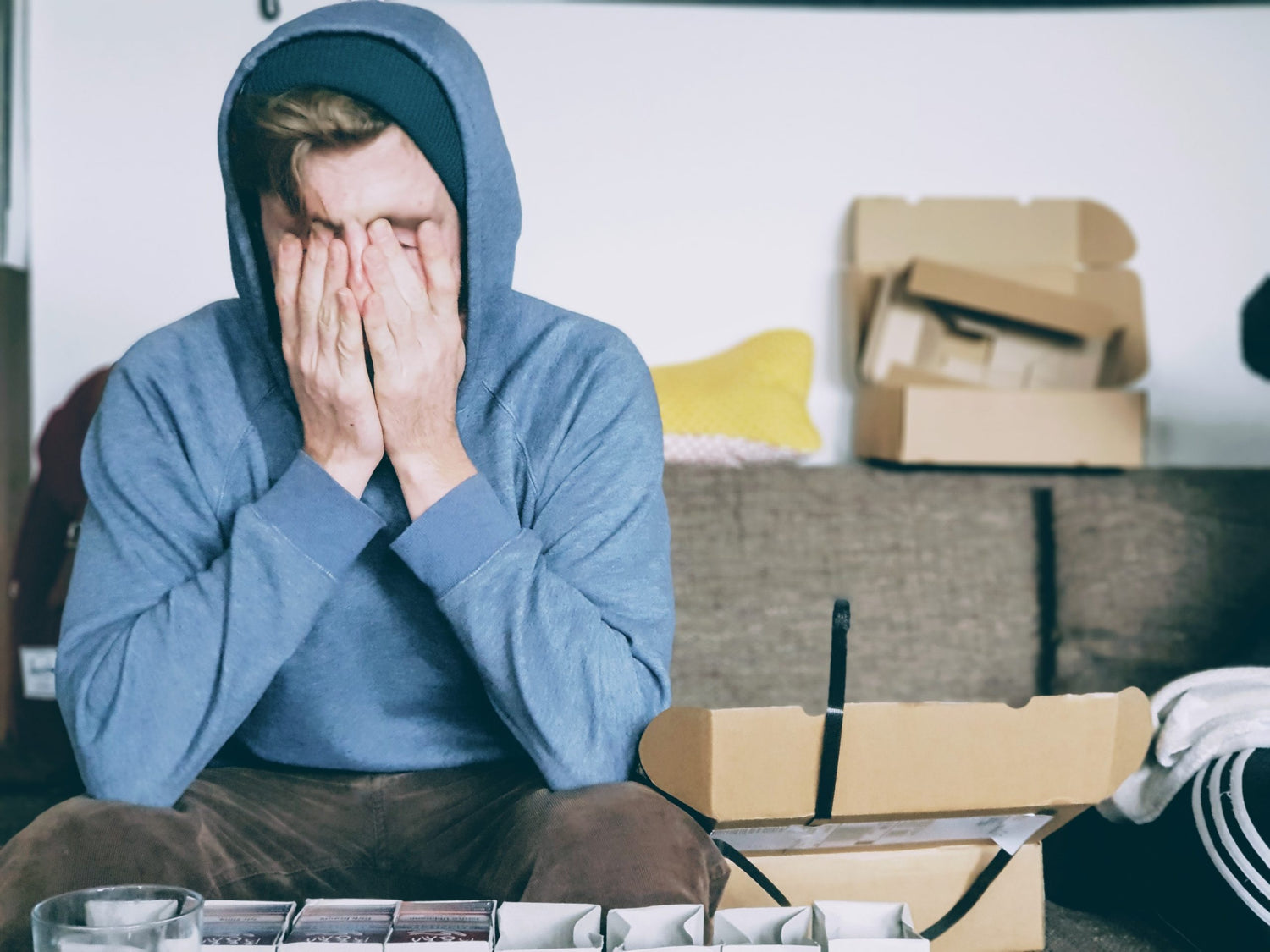You know it when you feel it. You walk into an office or retail store, and whether it happens immediately or after a few minutes, it’s unmistakable. The fluorescent fixtures overhead are beaming out their flickering, harsh, and (at least to you) excessively bright light — and here comes trouble.

No matter what others believe, your sensitivity to fluorescent light isn’t all in your head. You can feel its effects, and it really does impact your life. Consider what John had to say about spending his days under fluorescent light:
“I work at a hospital with all fluorescent lighting and white walls. I was getting dizzy and headaches at work on a daily basis.”
Sound familiar?
In this article we’ll discuss why your eyes might be sensitive to fluorescent lights, and how to recognize the potential symptoms. We’ll talk about how sensitivity to fluorescent lighting relates to migraines, and give you some strategies that may reduce your exposure.
Why Are My Eyes Sensitive to Fluorescent Lights?
One reason you might have trouble with fluorescent lighting is the spectrum of light it puts out.
While sunlight produces a full spectrum of light, artificial light (such as fluorescent) produces a very limited spectrum. This narrow spectrum consists of primarily blue light. Blue light is shorter wavelength and scatters easily. This may be why it’s more troublesome to people in general than other types of light. Without a full spectrum to balance it out, that blue light can take its toll.
Another reason you may have sensitivity to fluorescent light is photophobia, or light sensitivity. While many people associate the word “phobia” with irrational fears, photophobia is a bona fide medical condition describing extreme sensitivity or intolerance for bright lights, or certain types of light. And the light emitted from fluorescent fixtures happens to be one of the main aggravators.
Photophobia isn’t incredibly common, but it does affect millions of people in the United States. It has a variety of causes. It may be a diagnosed medical condition, which means it’s something you’ll probably always deal with. But there are also several things that may cause more acute cases of photophobia, which may subside or stay with you long-term.

These causes include:
- Acute inflammation in the eye (iritis or uveitis)
- Eye infection, such as pink eye (conjuntivitis)
- Poor fit or irritation from contact lenses
- Abrasion / scratch or ulcer in the cornea
- Dry eyes
- Meningitis
- Traumatic brain injury
- Eye injury or disease (such as glaucoma)
- Recent eye surgery
- Dilated eye exams
- Side effects of some medications
- Migraine headaches
Even if you have no identifiable cause for photophobia, you could still be dealing with light sensitivity in your daily life. This hypersensitivity to light may bring on symptoms such as:
- Dry eyes
- Headaches
- Migraines
- Excessive tearing
- Involuntary blinking
- Involuntary squinting
- Burning sensation
- Nausea
Possible Symptoms of Fluorescent Light Sensitivity

At Axon Optics, we conducted a survey specifically about fluorescent lighting to get a better understanding of how fluorescent lights might affect migraine sufferers. We gathered over 1,600 responses. Our survey found that 33% of the participants have severe limitations when trying to function under fluorescent lighting. So if you experience unpleasant or even debilitating symptoms when exposed to fluorescent lights, you are definitely not alone!
Under fluorescent lights, you may experience any or all of the above symptoms. But there are other symptoms that seem to be related specifically to fluorescent lighting exposure that you may also be feeling, such as:
- Eye strain or discomfort
- Eye inflammation
- Fatigue
- Lightheadedness
- Blurry vision
- Difficulty concentrating
- Vertigo or dizziness
- Difficulty focusing or reading
- Shortness of breath
- Anxiety
- Feeling depressed
- Sleep disturbances
- Hormonal disruptions
Fluorescent Light, Headache & Migraine
When it comes to light sensitivity, the type of light makes a difference.
Brightness of a given environment has an effect, but so does the wavelength or color of that light. As we discussed earlier, blue light is more problematic than other types of light, and may cause eye strain and headaches. Fluorescent lights (along with devices like computers, TV screens, and smartphones) are a primary source of blue light.
There are two reasons why fluorescent lighting may trigger migraine or headaches. First, fluorescent light emits a large amount of blue light, which can trigger a migraine attack. Additionally, fluorescent lights have an invisible pulse, which can trigger headaches, migraine attacks, eye strain, blurred vision, double vision, and light sensitivity.
In the survey referenced above, 56% of respondents said that bright lights provoke headaches for them — and fluorescent lighting definitely qualifies as bright. 73% reported that bright light is very unpleasant during a headache. And the problem is bad enough that 85% of participants said they actually wear sunglasses to decrease their headaches (which is a bad idea…learn why here).

7 Ways to Relieve Fluorescent Light Sensitivity
Fluorescent lighting is inexpensive and efficient, making them the ideal choice for many businesses. This is why if you work in a retail setting or office building, you probably spend 8 or more hours per day being bombarded by fluorescent light.
Since you can’t very well go around turning all the lights off, you have to figure out how to deal with your situation.
Here are a few strategies you might consider.
Wear Glasses Designed for Light Sensitivity

Sure, you could wear sunglasses indoors, but that could end up dark adapting your eyes and making your problem worse. This is why glasses specifically designed for light sensitivity and migraine are a better choice. These glasses block the blue spectrum of light fluorescent fixtures are infamous for. Axon Optics glasses with Avulux® lenses also also block the red and amber wavelengths that a lot of sensitive people find bothersome. But it doesn't end there. These special lenses also let the rest of the light in — namely the soothing green light that counteracts the harmful wavelengths. The lenses been shown effective in clinical studies and clinical surveys, and more than a thousands have used them with good results.
Those include Axon Optics customer John, whom we quoted earlier about working in a hospital under fluorescent lighting all day. He continues:
“After realizing that it was the lighting that was causing me a headache, I did some research online after becoming pretty desperate for some relief. I ordered a pair, and since then they have worked great.“
In fact, in a HIT-6 headache impact study we conducted, we found that 85% of Axon Optics users for light sensitivity have had great results using the glasses when they’re under fluorescent lights. This data is specific to Axon Optics.
Take Frequent Breaks
When the fluorescent lighting at work starts to bother you, get outside for a bit with your Axon Optics with Avulux lenses. This will get you out of the irritating blue-heavy spectrum of light in the office into the broader spectrum of sunshine. And hey, you might also find yourself with a sunnier attitude when you return.
Use Physical Barriers
When it’s behind a “shade” or cover, fluorescent lighting is less irritating.
In your office or cubicle, try draping some fabric or even setting up an umbrella to give you some shade. It might look a little strange, and your employer might have to approve it, but it can really help. Just make sure that what you’re doing isn’t too bothersome to the people around you.
Put on a Hat
If it’s okay with your company dress code, a wide-brimmed hat can shade your eyes and bring some relief. (Just beware of “hat hair.”)
Install Dimmers
Talk to your employer about adding some dimmers. If the lights in your office or over your desk don’t affect other people, you may have some level of control. Then you can add a regular lamp with an incandescent bulb if you need extra light.
Unscrew Fluorescent Bulbs

If your employer will allow it (you probably want to ask first), you can try unscrewing the fluorescent bulbs above your desk, or see if the maintenance crew can replace those particular bulbs with burned-out bulbs to lessen your exposure.
Use Natural Light
If you can, move your desk closer to a window or overhead skylight. Take a look around these potential areas first, to make sure you won’t be exacerbating photophobia by being exposed to glare from nearby water or buildings.
If you can get more natural light, maybe you can turn the fluorescent ones off or balance out the blue spectrum light with full-spectrum sunshine.
Sensitivity to Fluorescent Light Doesn’t Have to Keep You in the Dark
Your challenges with this type of lighting may be due to overall light sensitivity. Or, you may just be sensitive to fluorescent lights. In any case, the precision-tinted Avulux lenses in Axon Optics and the strategies above can help you ease your discomfort in a non-invasive way. Since the glasses are easy to put on and remove and don’t affect the people around you, this may be the easiest method to simplifying your life with light sensitivity and migraine. We hope they help you deal with fluorescent lights without staying in the dark.
References
1. Adams, C. (2019, August 28). How Fluorescent Lights Affect You and Your Health. ThoughtCo. https://www.thoughtco.com/how-fluorescent-lights-affect-you-1206641
2. Blackburn MK, Lamb RD, Digre KB, Smith AG, Warner JE, McClane RW, Nandedkar SD, Langeberg WJ, Holubkov R, Katz BJ. FL-41 tint improves blink frequency, light sensitivity, and functional limitations in patients with benign essential blepharospasm. Ophthalmology. 2009 May;116(5):997-1001. doi: 10.1016/j.ophtha.2008.12.031. PMID: 19410958; PMCID: PMC2701948.





